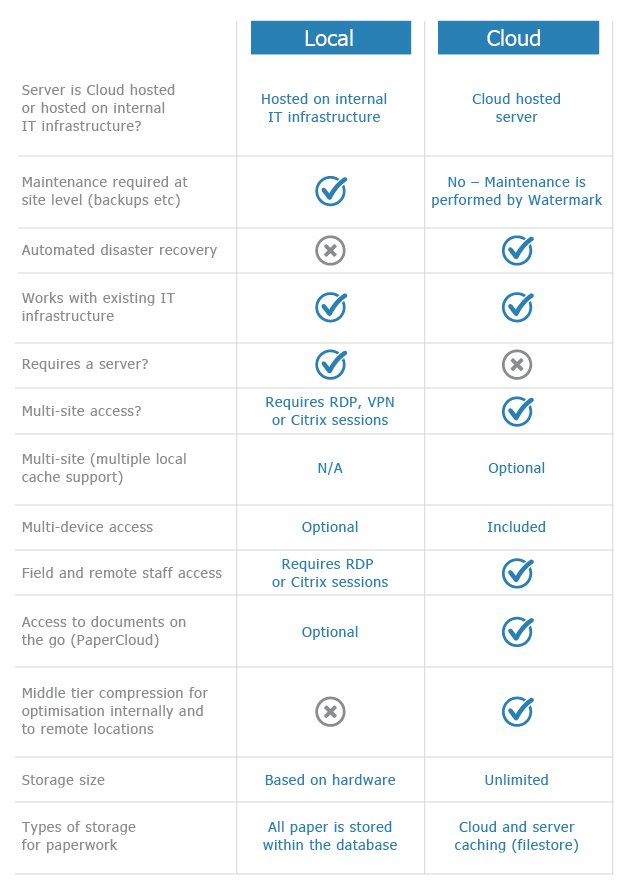Cloud document management software – the Watermark way!
The Cloud seems a big deal these days with most of the big tech companies providing ‘cloud based solutions’. At Watermark Technologies we didn’t just want to jump on a bandwagon for the sake of it and develop cloud document management software. We wanted to understand our customers and how a cloud based solution would serve them better.
The problem with The Cloud
Depending on the provider, ‘The Cloud’ can be interpreted differently. Many ‘cloud solutions’ come with bold promises of cost savings for businesses, and the guarantee of more staff productivity than you ever thought possible. Yet in reality all they have done is taken the simplistic approach of putting the word ‘cloud’ in front of all of their existing software, services and products, without changing much else. The Cloud for these companies has simply been a rebranding exercise.
For us the word cloud isn’t a brand term, but rather a response to an agile workforce, which is constantly connected and continually dipping in and out of their work.
The challenge we faced as a business was to not just develop cloud document management software to tick a marketing box. We wanted to deliver a solution that would genuinely solve problems and address the challenges the businesses we serve are facing.
We thought we would take a moment to share some of our insights into the ever-changing and evolving world of technology.
A Guide to Today’s Document Management Solution
Have you ever stopped to wonder when technology started to rule your life? Planning your evenings around your favourite television programmes; a need to be constantly connected to the internet, or simply looking for a plug to recharge your mobile device – but when did we get like this?
Many of us can still remember the days when offices were made up of typewriters, fax machines and large desk bound computers, but for Generation Z and Millennials (those born in the 1990’s and raised in 2000’s) this is incomprehensible; even paper is increasingly old-fashioned to this computer savvy generation. This is a generation that think very differently because computers have always been in their lives, they are the first generation in the history of mankind to experience life through the lens of technology.
Where today’s technology came from……
The good old typewriter first became commercially successful in 1868. It wasn’t until the 1980’s that this technology was displaced by word processors and personal computers. In the modern-day working world it would seem very old-fashioned to use a typewriter. And what about fax machines? This form of communication remained popular during the end of the 20th Century having originally developed from a technology which sent images over a wire in 1924. There is no longer a need for the traditional fax machine in the office; this being said, the invention of the 3D fax created a stir in the early 21st century as a method of scanning and transmitting 3 dimensional data.
The computer continues to be an office staple but the nature of this has changed dramatically over the years. The first generation of computers were produced between 1945 and 1960, they used punch cards and made use of thermionic valves. The next 20-25 years saw two more generations of computer and in 1981 IBM introduced its first computer for the home user. In 1984 apple introduced the easily identifiable Macintosh, Microprocessors also moved out of the realm of desktop computers.
Can you imagine not being able to email somebody instantaneously or ‘talk’ business away from the office? It is essential that the modern day office worker is able to continue working on the road, abroad and outside the hours of 9 to 5. Modern day technology is designed with this in mind.
Fifth generation computing devices, based on artificial intelligence, are still in development: however there are some applications such as voice recognition that are already being used today. Fifth-generation computing aims to develop devices that respond the natural language and are capable of learning and self-organisation.
It’s all gone mobile
It may be hard believe that the first mobile phone was demonstrated in 1973 and in was only in 1983 that we saw the first –of them become commercially available. 1990 to 1995 saw an upward swerve in design and portability, this was when mobile devices starting appearing in the hands of the average customer, with Nokia being the most recognised brand.
The truth is that 93% of adults in the UK own/use a mobile phone suggesting that we simply cannot live without them. It would seem that mobile phones have become a life-long necessity in a relatively short space of time. This being said, the nature of the ‘mobile phone’ has changed dramatically, the latest mobile devices aren’t actually much like a ‘phone’ at all- they may be able to make and receive calls but their selling points are so much more than this.
Now, gadgets once seen as necessities are longer no necessary with the continual development of multi-purpose mobile devices. These devices have increasingly high quality cameras, connection to the internet allows emails to be received and sent away from the office and music and programmes to be streamed and downloaded on the go. With the continual development of mobile devices many gadgets have already been made redundant, others we continue to use alongside mobiles such as a laptop or television.
In this ever-developing technological world where you can contact anyone anywhere in the world instantaneously by simply having an internet connection, it seems ridiculous that individuals and businesses are still relying on paper. Letters are now emails; tax discs are paperless; banking and payments are available online; paper signatures have been replaced by digital signatures; newspapers and magazines are available digitally; cards can be sent as e-cards….the list goes on….so why are the majority of businesses unable to run efficiently without physical paper?
Finding the right document management software could be the answer. A system which allows you to track, manage and store documents digitally.
Volume, move with the times….
Say ‘goodbye’ Fax machine and ‘hello’ to Camera Scan. ‘Goodbye’ typewriter, ‘hello’ audit tracking. ‘Goodbye’ desk bound telephone, ‘hello’ mobile device. ‘Goodbye’ filing cabinets, ‘hello’ digital cabinet. ‘Goodbye’ paper, ‘hello’ document management system.
Volume document management software was designed with people in mind; a system that is simple to learn and easy to use, yet sophisticated enough to manage the needs of the most complex organisations. No need to change business processes, it allows you to continue to work the way you want to in a digital paper-free environment. No indexing ensures that scanning and filing into Volume is simple, no high-skilled training needed. Find documents exactly where you expect them to be by using the only system which reflects paper processes in a digital environment.
There are a number of different options when accessing Volume. Whether you want to use your existing office-based IT infrastructure (Volume-local), the power of Volume combined with the versatility of your cloud (Volume-cloud) or cloud or server stored data via local cached documents provides unlimited and simultaneous access anywhere in the world (Volume-global)- Volume does it all!
It’s no longer just your head in the clouds….
Moving with the times isn’t just about removing archaic machines and practices from your office – it’s about transforming the way your whole business communicates. Best practice demands that staff are mobile, your information accessible (securely) and your systems flexible. Volume document management provides the freedom of the cloud with the practicality of desktop AND mobile access – we call it ‘Cloudish’ – providing your business with the best of both worlds.
Cloud computing has achieved mainstream deployment in the UK according to the latest research from the Cloud Industry Forum; with 78% of organisations now consciously using cloud services.*****
But what really is cloud storage?
Cloud storage is a service model in which data is maintained, managed and backed up remotely and made available to users over a network, typically the internet.
Why people love the cloud…
- Access data anywhere on any smart device
- Frees up IT resources to focus on the core competency of the business
- Provides scale so that you can easily provision additional servers to meet computing needs
- Reduce IT and server costs
- Provides a low cost, easy way to ensure backup and disaster recovery with offsite backups
- Enhanced security from Internet services
There are many drivers for Cloud adoption; flexibility continues to be cited as the primary reason for adoption amongst private sector companies, while operational cost savings dominates the public sector. Earlier this year 61% of organisations reported running Windows Server 2003, which formally stopped being supported in July of this year; businesses are still seeing the impact of this. Replacing a server can be a costly and timely process; however, finding the right Cloud storage option could quickly eliminate this headache.
Why people love our Volumeremote product…
As well as the benefits listed above; Volumeremote allows businesses to hold information in an external environment to the business and have seamless access to it from anywhere in the World. The Volumeremote option allows users to move away from their in-house server, Terminal Server and CITRIX environments, and access Volume directly from a desktop in the office or a mobile device on the go.
This has proved popular with our Volume users; many of whom have recently switched from a terminal server or CITRIX environment to Volumeremote. Our in-house team of expert engineers ensure that the changeover happens quickly and efficiently with no disruptions to allow you to continue with business as usual.
CitrixTS environment tend to charge hosting fees per user, per application as well as a cost for the hosting and maintenance required for the server and database. Volumeremote allows users to choose the environment which meets their business needs; we look after server licensing, maintenance, backups, and monitoring. Servers are maintained by our skilled engineers and data is held in the cloud using Microsoft Azure.
Moving forward with Volume
Technology is the future; paper is rapidly becoming a thing of the past. If your company hasn’t started preparing the move to paperless you’re already behind the times resulting in you being behind the competition. Switching to paperless and storing data in the cloud are two of the biggest trends of 2015. Make the change now or you will be kicking yourself later.




